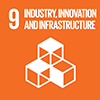June 2022 - You are accessing an old version of our website. The SDGs Voluntary Commitments have been migrated here: https://sdgs.un.org/partnerships
You will be redirected to the new Partnership Platform in 10 seconds.
June 2022 - You are accessing an old version of our website. The SDGs Voluntary Commitments have been migrated here: https://sdgs.un.org/partnerships
You will be redirected to the new Partnership Platform in 10 seconds.
ICT4SIDS Partnership (#8005) was formed in the 2014 Samoa Conference by a small team of researchers and engineers, led by Dr Amjad Umar. Dr Umar was an Adjunct Professor of Systems and Telecommunications Engineering at the University of Pennsylvania at that time and had previously started a research project on Computer Aided Planning at Bell Labs for small businesses. We started by using our computer aided planning toolkit to quickly form the ICT Hubs suggested by the Samoa Pathway. The toolkit has been significantly expanded to address the most difficult challenges raised by SDGs and now for the Urban Agenda.
Our objective is rapid implementation of SDGs at a massive scale by deploying inexpensive smart hubs that provide low cost but high impact SDG services to underserved populations [1]. By definition, a smart hub is a center of activity, supported by a set of powerful portals, that provide location specific services of high value to its users. A smart hub may be totally virtual (i.e., located in the cloud) or a physical building with access to the hub portals. The following four distinguishing features of our work make it an effective response to the SDG/2030 and the Urban Agendas:
I: SMART HUBS TO ADDRESS THE BASIC CHALLENGES: Each smart hub addresses many SDG challenges by providing highly specialized region and population specific low cost and high impact services in health, education, public safety, public welfare and other vital sectors. Specifically, each Smart Hub supports the following powerful portals so that no one is left behind [12]:
• Administration Portal that has prefabricated plug-ins for collaboration, business intelligence, observatories, decision support, security and project management.
• End-User Portal that directly supports SDG specific activities of the end-users (e.g., patients to get healthcare help, farmers to launch e-agriculture initiatives, and children in remote areas to get basic education)
• A Capacity Building Portal to educate the Hub-Masters to become successful entrepreneurs
II: SMART GLOBAL VILLAGE (SGV) FOR REGIONAL GROWTH THROUGH COLLABORATIVE HUBS: These smart hubs are designed to collaborate with each other to form a Smart Global Village (SGV) for the Underserved Populations. An SGV consists of smart collaborating hubs located in small islands, small towns and isolated communities. Members of an SGV can [13]:
• Collaborate with each other and also with a Global Center for HelpDesk capabilities
• Operate eco systems with entrepreneurs from different countries on different topics
• Support SDGs plus the UN Urban Agenda by gradually transforming regions
III: COMPUTER AIDED PLANNING METHODOLOGY FOR RAPID & MASSIVE IMPLEMENTATION: This methodology is based on free pilot projects so that the poorest populations and young entrepreneurs can participate. The most innovative aspect of our methodology is that it uses a “Hub Factory” to produce a complete smart hub in about an hour, create a community center in about a day, a village in two days, and a regional SGV in about a week (Smart Solomon was created in a week!). This acceleration changes the dynamics of our projects [14].
IV: ACADEMIC RESEARCH TO DEVELOP AN ADVANCED “HUB FACTORY” TO QUICKLY PRODUCE HIGHLY SPECIALIZED AND SOPHISTICATED SMART HUBS: We have developed a Hub Factory that supports the aforementioned computer aided planning methodology. This factory, called SPACE (Strategic Planning, Architecture, Controls and Education) uses an extensive array of latest developments in “additive” manufacturing, AI, Big Data, gamification, business patterns, technology patterns, and management patterns [5]. SPACE is a research prototype that is being extended and enriched because of its use in deploying and managing the growing SGV (60 hubs in 15 countries at present). Several research papers have been written about SPACE [6, 7, 8, 9].
We primarily operate through Free Pilot Projects that are offered to any individuals, groups or enterprises in SIDS and LDCs. The key stakeholders in our Partnership are:
• Beneficiaries: The respondents to our Pilot Projects (advertised on the http://ict4sids.com) are young entrepreneurs, NGOs, Teachers from Community Colleges, mayors of small towns, community workers, and govt officials. The respondents go through an interview before they are assigned as POCs (Points of Contact).
• Implementers are members of NGE Solutions – a startup
• Partners are Harrisburg University, IBM (donor of a machine) and a large number of subject matter experts from industry, academia and governments
As stated previously, our main objective is to quickly identify and launch low cost but high impact services in health, education, public safety, public welfare and other vital sectors for any location anywhere in the world. The major challenges we face are:
• Where exactly should a hub be located for maximum benefit to the community?
• What type of low cost and high impact service(s) should be provided for the area?
• What business strategy should be used and what will be the ICT and energy infrastructure?
• What are the security, privacy and policy issues that must be addressed?
• What are the needed project management and governance aspects for the hubs?
• How can the large number of hubs be implemented quickly and inexpensively?
Due to these and other complex issues, the failure rates of ICT projects of this nature are very high – around 80% in developing countries [21, 22]. To address these challenges, we developed a computer aided methodology that is based on free pilot projects. In the first stage of this methodology, we invite any potential user to initiate a free pilot project by submitting a short proposal that specifies the objective of the proposed hub and the target location (preferably SIDS and LDCs but we serve underserved populations anywhere in the world, include USA). An SDG Advisor tool (part of SPACE) helps the users to assess their needs and determine which SDG services will be needed in the proposed hub. Specifically, the SDG Advisor [16] conducts a quick feasibility study by asking the following questions and then helps a user to select and launch low cost but high impact smart hubs:
• What is the objective of the proposed pilot project?
• What is the status of the target country/region for SDGs of interest?
• What type of hub services could improve the needed status?
• Which services are low cost but high benefit within the local context?
Based on this quick analysis, and a short skype interview, a hub vision is clarified and a pilot project is initiated by appointing a user Point of Contact (POC) who also serves as the hub master. The methodology, explained later, then uses an innovative Computer Aided Planning tool, called SPACE, to quickly generate a highly specialized Smart Hub for the site selected by the POC. The POC is then trained to use the generated hub as an entrepreneurship opportunity and works with our team to refine and launch the Smart Hub for public use. In the Launch stage, all hubs are automatically “registered” in the Collaboration Matrix and also in the Smart Global Village. The Pilot Project concludes based on a detailed plan for future deployments with expansions, management and governance considerations. Please visit (http://ict4sids.com/methodology.html) for additional details on this implementation methodology.
Please recall that each Smart Hub has an Administrative Portal that has extensive monitoring and governance capabilities to enable the POCs to become successful entrepreneurs.
Additional information about our implementation approach can be found in [1, 2, 3]
Our methodology and the SPACE Factory have been used for rapid generation of more than 60 smart hubs in 15 countries that span Asia, Africa, North America and Small Islands. The Sample Smart Hubs Site (http://ict4sids.com/proj.html) displays only a few interesting results of our work such as the following:
• Healthcare and Education Centers in Pakistan, Nigeria, Tanzania, and Bangladesh
• A Fisheries Center in Sri Lanka, a Solar Energy eMarketplace for Nigeria, and an e-Agriculture Center for Togo
• A sustainable tourism network in Maldives and Solomon Islands, and Disaster Management Centers in Timore Leste and the Solomons
• A Domestic Violence Center in the Republic of Georgia
• Smart towns in Pakistan (Lahore) and the Solomon Island (Honiara)
• A large scale Smart SIDS initiative with initial focus on the Solomons
• Examination of hypertension data from Haiti, Peru and El Salvador
In addition to the actual Smart Hubs, the few Pilot Invitations shown on this page can serve as testimonials that these are real projects. The status reports (http://ict4sids.com/projdoc/statusreport2018.pdf) and (http://ict4sids.com/projdoc/Nigeria%20Project-Concept.pdf) provide additional testimonials of our work in the Indian Ocean and Nigeria.
This sample site shows the diversity of topics (almost all SDGs) and the locations (almost all continents) covered by Smart Hubs. The key outputs and results of our work so far are:
· The approach of highly focused pilot projects (duration: 3 months) works very well -- we quickly learn what really works and also provide educational and entrepreneurship opportunities for the POCs.
· The POCs of each hub are required to communicate and collaborate with at least 3 other hubs as part of the training program. They initially exchange educational materials and lessons learned but later start exchanging other vital information such as evacuation procedures in case of a disaster and digital marketing approaches and experiences for cottage industries.
· The Smart Global Village (SGV) of underserved populations collaborating with each other is giving us unprecedented opportunities to collect, combine, and analyze highly valuable data from very diverse populations from different sectors living in different parts of the world.
· The Global Center of the Village, located in USA, can remotely monitor the disaster resilience capabilities of smart hubs located anywhere in the world.
For further insights, let us look at the Smart Solomons Project (videoclip: https://youtu.be/1eJGqGh7ruk), and smart Solomon site (Link:http://ict4sids.com/Solomon.html) that is attempting to transform the Solomons into a smart island by 2020. The Smart Solomons Home Page supports eight Hubs at the national level (health, education, disaster management, energy management, e-agriculture, e-commerce, entrepreneurship, and tourism), a Smart Honiara Hub to support the city of Honiara as a smart town, and a community center for AreAre rural area for health, education, and tourism. Collaboration scenarios include a tourism hub in AreAre collaborating with micro-entrepreneurship and micro financing hubs in Pakistan, Maldives and Harrisburg. Also, blood pressure readings at the AreAre Center can be sent to the National Healthcare Center in Solomons and the Global Healthcare Center located at Harrisburg. These centers can also collaborate on medical supplies [13].
Our main success factors are: a) clear vision of smart hubs that collaborate with each other to form a Smart Global Village (SGV), b) a Computer Aided Methodology based on a SPACE Factory to produce smart collaborating hubs and SGVs quickly and inexpensively, and c) Financial limitations as a driver for innovation.
SMART GLOBAL VILLAGE FOR ENTREPRENEURS: Entrepreneurship is the key to economic growth, especially in developing countries. For example, a UNESCAPE Report [20] highlights the growth of ecommerce entrepreneurship in Southeast Asia. Based on first hand experience, we have found that each hub is a potential entrepreneurship opportunity and thus our methodology trains each POC to be an entrepreneur by using a hub. For example, young nursing graduates can use healthcare hubs to launch healthcare centers, farmers or their family members with good education can launch farmer education centers, and guesthouse networks such as GAM can trigger multiple entrepreneurship opportunities in tourism and hospitality business. We are promoting SGV as a global eco system for entrepreneurship that supports creative opportunities by the Hub Masters at diverse locations with different backgrounds to collaborate with other entrepreneurs . We have some preliminary but highly promising results so far. Based on that, we have developed an Entrepreneurship Portal that supports hub-based training and education [18].
COMPUTER AIDED METHODOLOGY AND SPACE FACTORY: This methodology quickly identifies and launches low cost but high impact smart hubs in all SDG related sectors for any location anywhere in the world so that no one is left behind. We are also conducting serious academic research at present to transform SPACE into an advanced “Hub Factory” that can quickly produce highly specialized and sophisticated smart hubs at a massive scale to form highly creative SGVs. We are using a mixture of additive manufacturing, AI, deep learning, Big Data analytics and post processing techniques to significantly improve the smart hubs. SPACE behaves as a “factory” with the following capabilities [15, 8, 9]:
• Patterns Repository contains an extensive library of business, technology and management patterns that are used to populate the Smart Hub Portals. For example, our business patterns repository contains around 200 patterns that span 12 industry sectors. These patterns can be also combined into complex “bundles” to represent offices, community centers, and enterprises.
• Games and Simulations support strategic analysis, ICT planning, interagency integrations, project management and governance activities of the methodology.
• Planning Tools (e.g., strategic and detailed planners), advisory systems (e.g., the SDG Advisor), and other specialized tools (e.g., entrepreneurship portal) that systematically guide the users through various decisions in strategic planning, architectures, integration, acquisition, security, governance and project management activities.
FINANCIAL LIMITATIONS AS A DRIVER FOR INNOVATION: Financial limitations became our driver for innovation because we could not hire large technical staff to build, customize and support large number of highly specialized smart hubs to support all the SDGs. So, we decided to keep a small team and are focusing on the SPACE Factory to “manufacture” smart hubs -- a highly interesting area of future research
We have a sustainable business model that is based on a small team with heavy focus on computer aided planning, engineering and management of Smart Collaborating Hubs. We are using the lessons learned and insights gained from the Partnership to operate a successful software development, consulting and training firm (http://ngesolutions.com). The firm is providing tangible business opportunities to young entrepreneurs who want to use these hubs to form telemedicine centers, ecommerce centers for cottage industries, training centers for farmers, tourism networks, domestic businesses for women, and emarkets for solar energy (see the samples displayed on http://ict4sids.com/proj.html).
Based on the insights gained through numerous hands-on experiments, we feel that significant improvements in rural/urban transformations can be achieved through a set of collaborative smart hubs as a possible alternative to large scale smart cities initiatives as stressed in the UN Urban Agenda. In terms of cost/efficiency implications, our approach is based on low cost but high impact services. As stated previously, we offer free pilot projects and then provide complete technical support and training of hub masters at $50 USD per month per hub.
Plans for extending the practice more widely and encouraging its adoption in other contexts are:
• We are reducing the duration of free pilot projects from 3 months to 1 month starting March1. The reason for this reduction is that by now our team has gained enough of experience and the SPACE platform has become efficient enough so that we can get the free pilot projects done in 1 month. This allows our team to triple our projects without increasing the team and costs.
• Instead of replicating one hub (e.g., a hypertension clinic) lets say in Africa, we keep enriching the SPACE Factory and diversifying the geographic locations so that we can cover more SDGs in more SIDS and LDC locations as displayed on http://ict4sids.com/proj.html page.
We also intend to pursue the following areas of practical research to further improve our methodology and the SPACE Factory:
• What would be the exact tradeoffs between smart city solutions based on gradual implementation of smart hubs in selected neighborhoods versus large centralized solutions for the entire city.
• How can the success rate of pilot projects be further improved. Almost 80% of our projects are successful – the main failures happen in the last Phase due to the lack of financial resources to the young entrepreneurs who want to be hub masters. We are seeking innovative models to fund $10k per hub as seed money for the entrepreneurs who are already well trained to run a small business by using a smart hub.
• How can the current SPACE Factory be expanded for massive generation of almost a million smart hubs to support more than 3.5 billion underserved people by using the next generation of digital technologies.
• What type of unique collaboration scenarios and protocols will be needed to capture the global entrepreneurship ecosystems (e.g., eccommerce) in an SGV. For example, will a light weight NIEM (National Information Exchange Model) be needed for developing countries
Finding solutions that address massive needs of almost 3.5 Billion people -- as captured in the UN SDGs -- is a daunting task. We have presented an architectural vision of a smart global village (SGV) that is based on smart collaborating hubs to serve these populations. These hubs provide inexpensive and highly specialized services in health, education, public safety, public welfare, energy and other vital sectors for the populations that are being left out of the digital revolution. We have identified the key challenges faced by massive implementation of smart collaborating hubs and developed a computer aided methodology plus the needed “SPACE Factory” that attempts to answer these challenges.
The result of our effort is a smart global village, consisting of several smart hubs, that is currently operational and is actually being used to help developing countries and small to medium businesses make progress towards SDGs. In addition, this village is being used extensively to support graduate courses and professional education in computer aided strategic planning and enterprise architectures and integration.
We have learned the following invaluable lessons in this project:
• As mentioned previously, every hub is a potential entrepreneurial opportunity for young entrepreneurs. Widespread availability of smart inexpensive hubs focusing on different topics with automatically plugged-in capabilities for collaboration and business intelligence could spark innovative entrepreneurial products and services. We are hoping that these digital innovations happen in remote areas and isolated populations that are being left out of the digital revolution.
• Women can find more entrepreneurship opportunities to run hubs as small businesses from their homes in backward areas where women cannot work outside their homes.
• Interactions and collaborations between different hub owners on different topics in different parts of the world can be of great value in discovering, understanding, and analyzing various large scale scenarios in a Smart Global Village that need future research.
• Business continuity planning (BCP) for small hubs is an active area of technology planning and transfer between many hub masters, at the time of this writing. This is automatically leading to disaster resilience in remote areas. Other common areas of interest will emerge as we gain more knowledge and insights with the rapidly growing SGV. These “bottom up” developments could lead to valuable results.
Our approach could also be used to support the UN Urban Agenda because the local smart hubs could provide the needed services to people living in rural areas to reduce the global urbanization trends. Our hypothesis is that people living in rural areas would prefer not to move to the expensive, congested and crime ridden cities if needed services are available at local hubs. For example, young entrepreneurs in Nigeria are going back to the countryside from Large Cities for a better life [19] . In addition, smart hubs can be used to provide needed services to a few neighbour-hoods of a large city and thus can gradually implement a large smart city plan instead of a centralized “one size fits all” solution.
NOTE: All References are Annotated for convenience
OVERVIEW INFORMATION
[1] “Smart Hubs for Rapid and Massive Implementation of SDGs” (http://ict4sids.com/newdoc/ICT4SIDS-002-Overview-March2019.pdf) – Note: this is essentially an expanded version of the Good Practices Submission with graphics and better explanations.
[2] UN ICT4SIDS Partnership, UN Registered Partnership No:8005, Website: http://ict4sids.com. Note: this site, heavily supported through video clips, has tremendous information of value to this report.
[3] SPACE – A Computer Aided Planning, Engineering & Management Environment, developed by NGE Solutions. Website: http://space4ict.com. Note: Also review [8, 9] for research papers on SPACE.
[4] UN High Level Platform Forum (HLPF) Entry: https://sustainabledevelopment.un.org/partnership/?p=8005. Note: This link shows the Yearly Progress Reports of ICT4SIDS Partnership, since 2015.
[5] “Indian Ocean Quick Status Report” from Vittorio Cocco, ICT4SIDS Representative in the Indian Ocean”, Feb 25, 2019, http://ict4sids.com/projdoc/statusreport2018.pdf
RECENT RESEARCH PAPERS– Published and Under Review for Publication
[6] Umar, A., “Smart Collaborating Hubs and a Smart Global Village – An Alternative Perspective on Smart Islands, Towns and Cities”, IEEE Conference on Technology and Engineering Management, June 2018. Link: http://ict4sids.com/newdoc/IEEE-TEMS%20SmartHubs-Final.pdf
[7] Umar, A., “Computer Aided Planning, Engineering and Management of Minigrids in Developing Countries”, short research working paper, Sept 2018. Link: http://ict4sids.com/newdoc/Computer-Aided-Planning-for-Minigrids.pdf
[8] Umar, A., “Computer Aided Strategic Planning for the United Nations Sustainable Development Goals”, International Journal of Engineering and Applied Sciences, ISSN: 2394-3661, Vol-4, Issue-12, December 2017. Link: http://ict4sids.com/newdoc/IJEAS-SPACE4SDGs-Published-Final.pdf
[9] Umar, A., and Zordan, A., “Enterprise Ontologies for Planning and Integration of eBusiness”, IEEE Transactions on Engineering Management, May 2009, Vol. 56, No. 2, pp. 352-371.
RELEVANT BOOKS (Published and Under Review)
[10] Umar, A., “Computer Aided Strategic Planning for Digital Enterprises”, Ingram Publications, Target Publication: Sept 2019
[11] Umar, A., “Computer Aided Architecture and Integration of Smart Enterprises”, Ingram Publications, Target Publication: Dec 2019
IMPORTANT VIDEOS AND INFORMATION LINKS:
[12] What is a Smart Hub: 3 Minute Video Clip (http://ict4sids.com/ved14.html)
[13] How Does Collaboration Help a Smart Global Village: 4 Minute Video Clip (http://ict4sids.com/ved4.html)
[14] What is Our Computer Aided Methodology: 5 Minute Video Clip (http://ict4sids.com/ved6.html)
[15] What is the SPACE Factory: 2 Minute Video Clip (http://ict4sids.com/ved9.html)
[16] SDG Advisor: Video Clip (http://ict4sids.com/ved7.html), Link to the Tool (http://space4ict.com/pages/sdgsadv.aspx)
[17] ICT4SIDS Partnership: Sample Pilot Projects, URL: http://ict4sids.com/proj.html
[18] Global Entrepreneurship Zone for All (GEZA): URL: http://ngegeza.com/
[19] “Nigeria: Young Entrepreneurs are Going Back to the Countryside From Large Cities.” https://www.trouw.nl/home/jonge-ondernemers-in-nigeria-vaarwel-stropdas-en-airco-hallo-platteland~aa6c8c48/.









 Start: 01 August, 2015
Start: 01 August, 2015 Completion: 31 December, 2030
Completion: 31 December, 2030